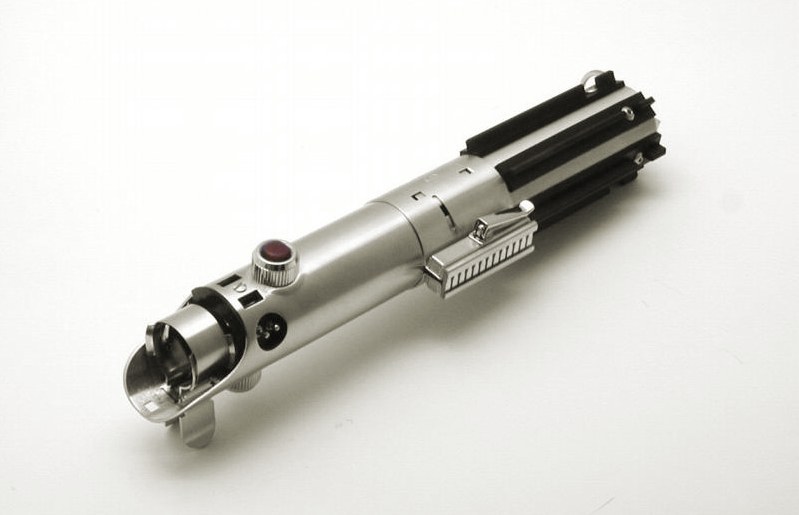 | 
In 1977, with the opening of A New Hope, a generation of movie-goers watched in awe as Obi-Wan Kenobi handed Luke Skywalker the lightsaber that had once belonged to the boy’s own father. In an instant, Luke ignited the blade – and for the first time, the world saw the glow, and heard the now-familiar hum of the sci-fi weapon that would go on to capture the imaginations of millions!
|  | |
 |
"."

If you own a Pacemaker Graphic for some time, chances are 99.9 %, you have seen those big flash synchronizers from years back.
Huge reflectors and bulbs (E-24) are from the same era. Not very practical today, but a certain curiosity and nostalgia remain, however dormant most of the time.
You may have seen the movie " The Public Eye ", starring Jo Pesci and Barbara Hershey, about the work and life of WeeGee.
Weegee was the pseudonym of Arthur Fellig (June 12, 1899 - December 26, 1968), an American photographer and photojournalist, known for his stark black and white street photography.
Fellig's nickname was a phonetic rendering of Ouija, due to his frequent arrival at scenes only minutes after crimes, fires or other emergencies were reported to authorities. He is variously said to have named himself Weegee, or to have been named by either the girls at Acme or by a police officer. (More at Wikipedia)
On a regular base, when watching movies those big machines and their huge flashes pop up.
Almost 30 years ago, the Graflex Flash synchronizer was converted into a laser sabre and appearing in several Starwars movies by George Lucas! (The one Luke Skywalker uses is the real Mac-coy.)
With the proliferation of electronic flash in the 1970s, these flashes were thrown out and sold in garage sales in great numbers. George Lucas happened to need a lightsaber prop for his Star Wars movie, these flash units were easily available! That is not the case anymore! Star Wars fans have placed a huge demand on the market and now the original Graflex flashes are hard to find and can command hundreds of dollars on Ebay! The three cell flash pictured in this article is the one that is the most popular.
There is a two cell flash, which looks very similar except that the bottom is slightly shorter. There is another type of Graflex flash which takes 3 D batteries (GrafLite). It is not like the one we will discuss in here and is not worth nearly as much, so look carefully if buying on Ebay! Some Heiland and MPP flash units can be worth something to Star Wars fans, but the Graflex 3 Cell is the most sought after.
Even today as I write (Oct. 23rd 2007), there it is again...
Today the Space Shuttle Discovery STS-120 will be launched. Luke’s original Jedi lightsaber will take its place in space for a mission to the international space station.
When the mission is complete and the Jedi lightsaber has traveled almost six million miles it will then be on display at the Space Center Houston and later returned to Lucasfilm.
Ever since, there was a rush and driving-up prices for the Graflex Flash Synchronizer by Jedi wannabees.
I you want to acquire a 1940's Graflex 3 cell flashgun (one that has been rescued from being turned into a light sabre), you will need patience and be willing to pay high prices!
Note: George Lucas made more money with his Graflex Star Wars Light Saber than Graflex ever made selling cameras! Believe it or don't.
So let's have a closer look at this special flashgun.

|
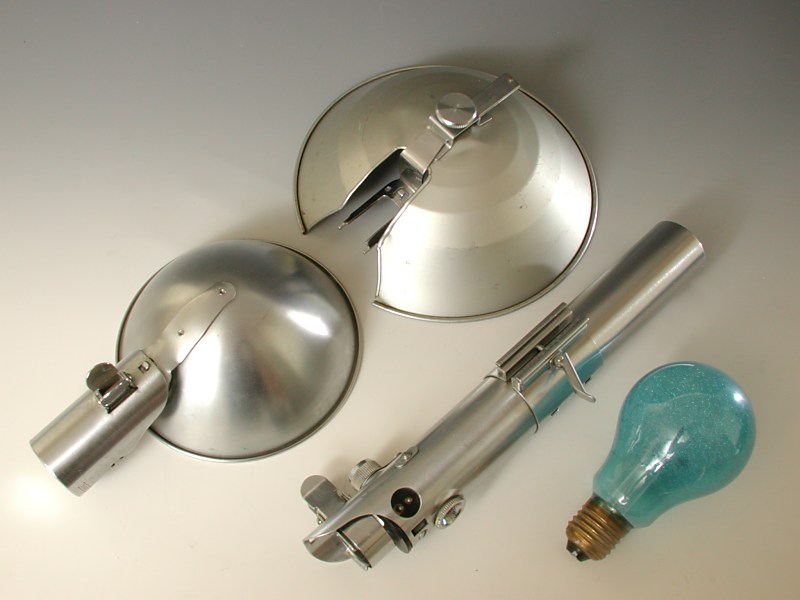
|  |
GRAFLEX Synchronizer: Lamps that go "Poof"
This GRAFLEX 3 Cell FLASH is the real deal, made out of chrome plated metal (1.22mm / 0.052"), used as a flash gun by photographers with the 4x5 Press cameras such as a.o, the Speed Graphic, Crown Graphic, MPP and Linhof Technika III.
|
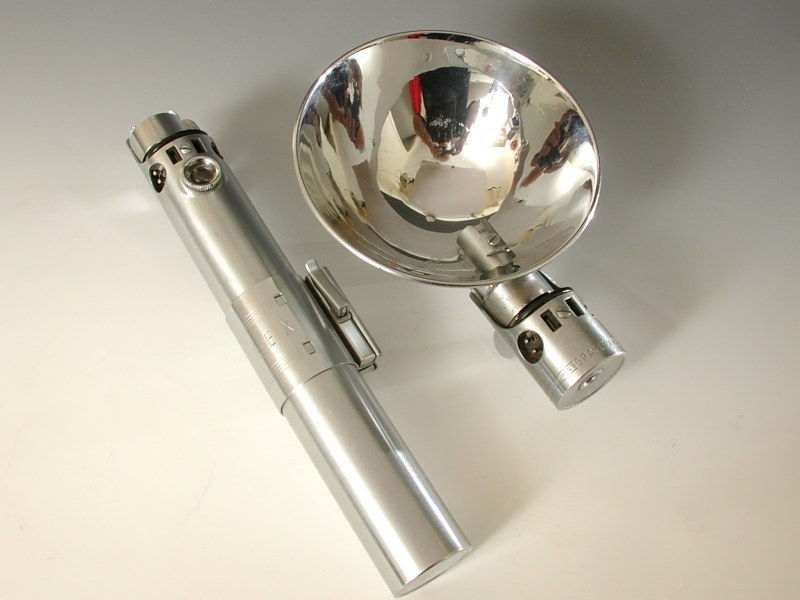
|  |
GRAFLEX Synchronizer part 1:
GRAFLEX Synchronizer 3 cell (D type) and side-lighting unit with 5 Inch reflector.
The Reflectors are interchangeable between de main unit and the side-lighting unit, but are totally different from the later GrafLite flashguns.
|

|  |
GRAFLEX Synchronizer part 2:
Both original relectors - 7 Inch and 5 Inch.
Note the special mount, making them obsolete for the GrafLite.
|
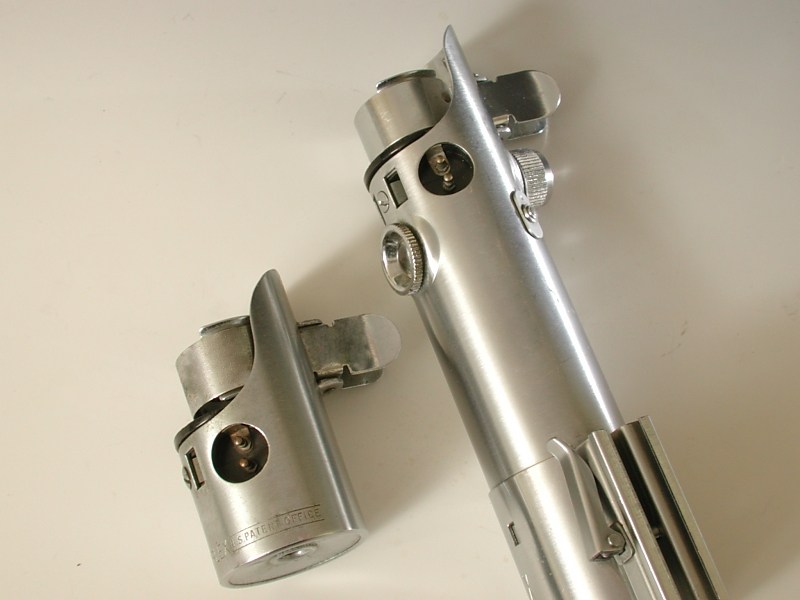
|  |
GRAFLEX Synchronizer part 3:
Detailed view of both units. Both have the typical round bi-post plug. To synch both units, you need a 5 meter cord with either Household plugs or bi-post sockets on both ends.
Well, one Household male tip and on the other end a Bi-post socket will work also ;-)
|
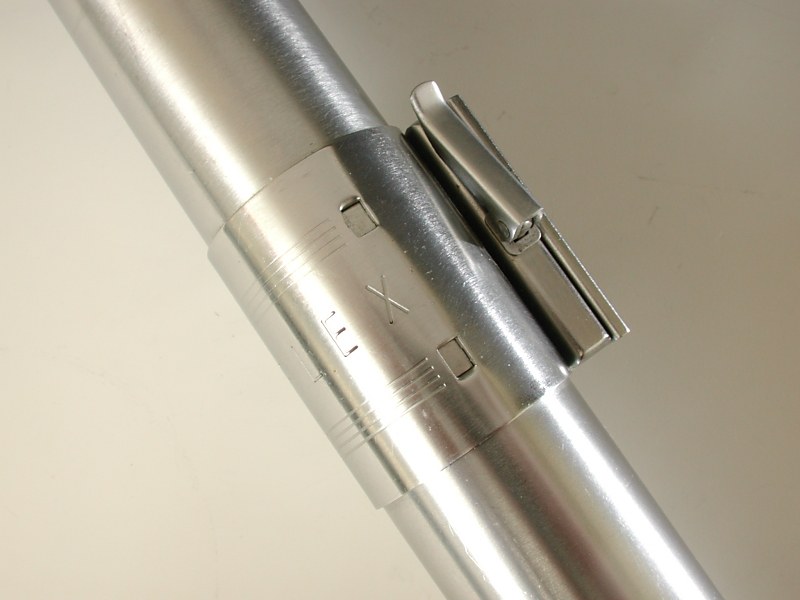
|  |
GRAFLEX Synchronizer part 4:
This is the middle part of the Graflex flashgun. Shown left is the integrated clamp, which can be adjusted for left or right handed use.
This clamp will mount directly on Graflex Pacemakers having the small metal bar on the Kalart RF. Surprisingly, it will fit on the Linhof Technika cameras also...!
Maybe not that surprizing, afterall the elder Linhof Technika's used the Kalart focuspot also.
|

|  |
GRAFLEX Synchronizer part 5:
Detailed view of the back. Note the red button (hard to overlook though). This button was used when the lens was connected with the Solenoid.
As soon as the button was pressed all outlets were hot. One of them was used to connect with the Solenoid.
If the lens had no Solenoid mounted, the red button was screwed off and was kept by a hinging ring. (AKA the 'beer can tab' as some like to refer to it.) Underneath a bi-post plug had to be connected with the bi-post contact on the shutter rim.
(Bi-post round socket to Bi-post socket.)
|
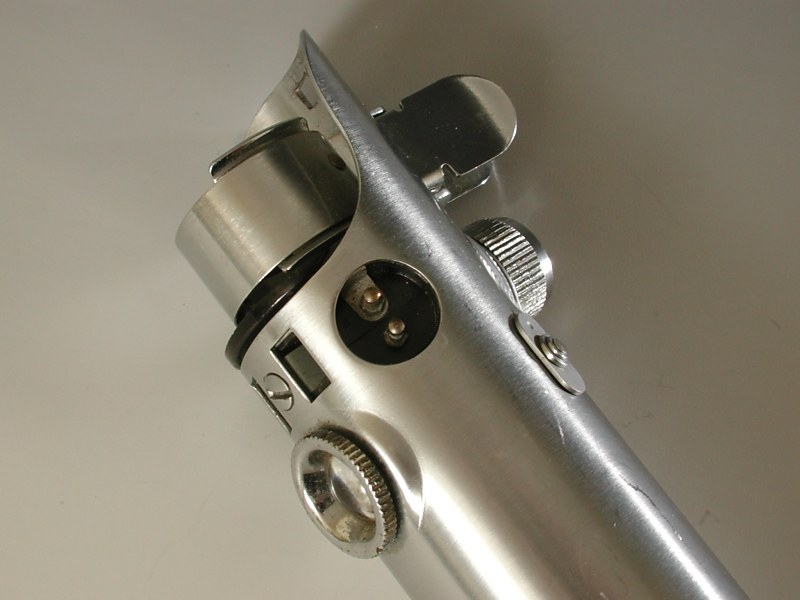
|  |
GRAFLEX Synchronizer part 6:
The front view shows the focus-assist light for low light levels (Aka 'glass eye' presumably due to its resemblance to a photo sensor). The light was also used to target a subject and help adjust the rotation of the unit for the optimal flash angle.
(Radio Shack #272-1132; #14 Screw-Base Lamp, 2.47 Volts 300mA.)
Also above the red button there is the mechanism to hold the bulbs called a "Pinch-clamp".
|
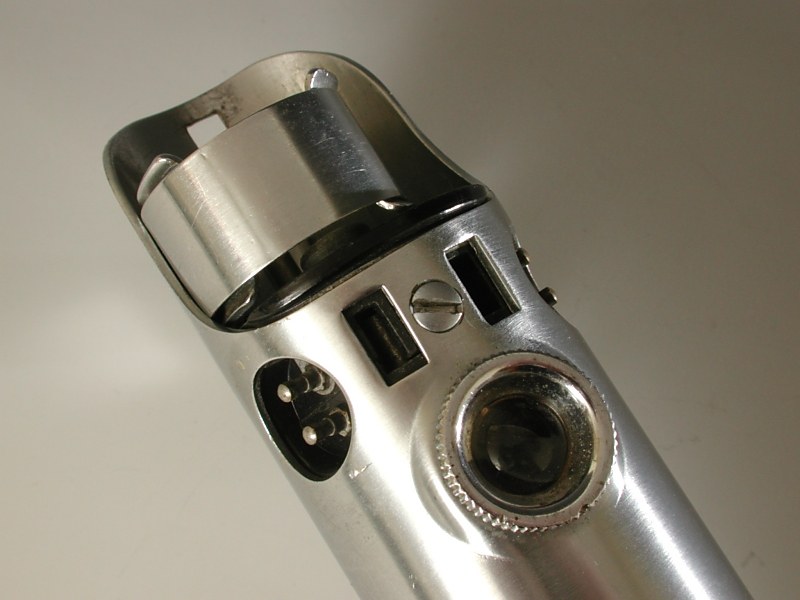
|  |
GRAFLEX Synchronizer part 7:
Front view of the top of the unit, showing the focus assist lamp and the Household socket. On both sides there is a Bi-post plug and also one on the back beneath the red button as mentioned before.
|
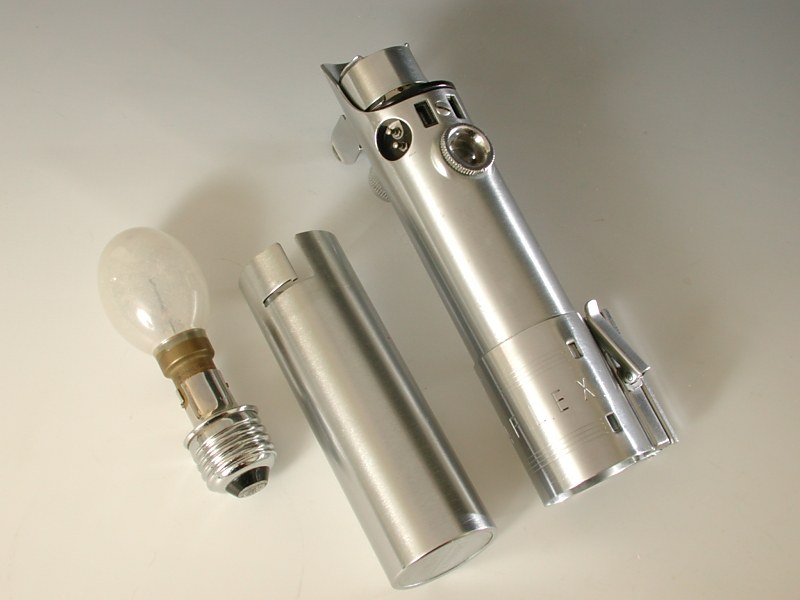
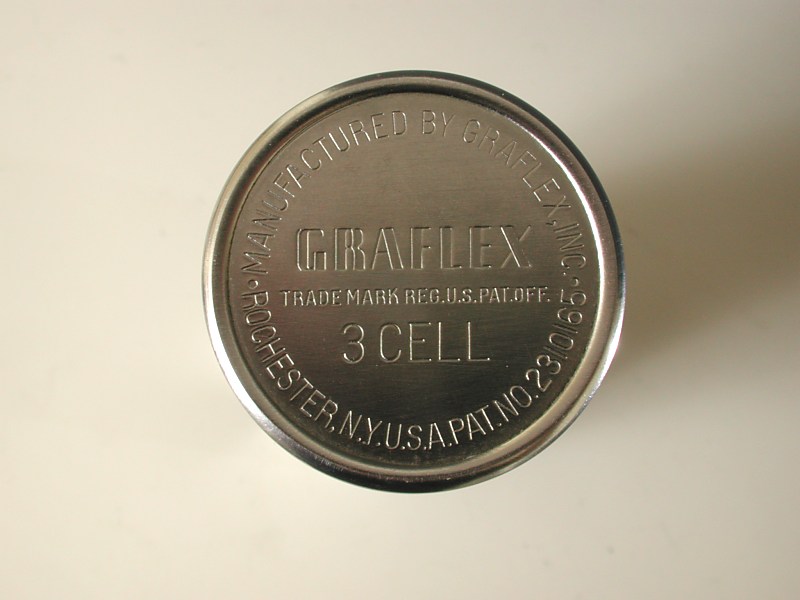
|  |
GRAFLEX Synchronizer part 8:
The unit taken apart in three pieces. The unit takes standard large bulbs (E-24) without any accessory, also bayonet type bulbs could be used with a special adapter.
The Side-lighting unit takes only bayonet type bulbs with the 5 In reflector. Larger bulbs can be used though when the 7 inch reflector is mounted.

When buying a Graflex Flash unit, the following is worth knowing:
As the demand for this type is huge and the availabilty of the originals is becoming scarcer every day, it was highly predictable somebody would jump on it.
Replicas exist (Good and bad ones), however these won't work the way you want it...
They are only used to make Light Sabers.
Look at the bottom end of the unit, it should look like this. (Instead of 3 Cell, there is also a legal 2 Cell)
|

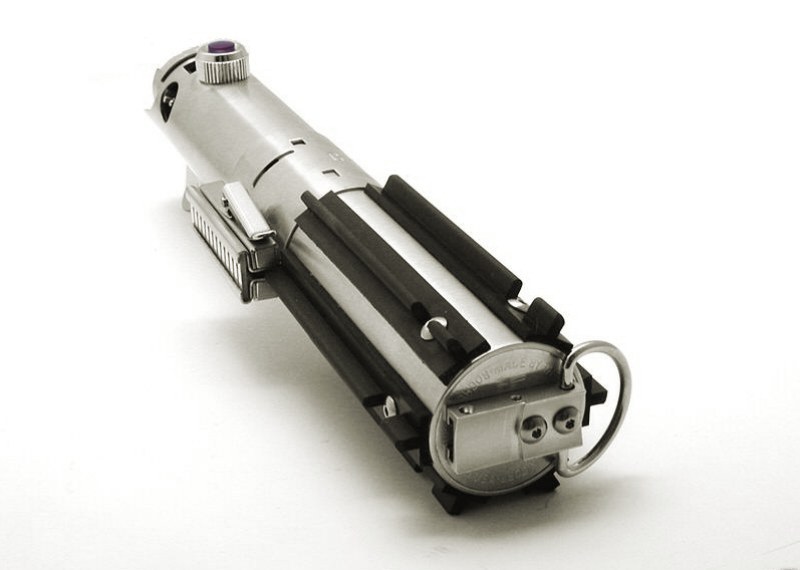
|  |
GRAFLEX Synchronizer part 10 (final):
Using Your Lightsaber Around the Home
Although a lightsaber is typically used as a defensive weapon by Jedi knights, the demand of lightsabers on consumer sites such as Ebay is growing since!.
If you are lucky enough to acquire a lightsaber, you are probably purchasing it for personal defense purposes.
A lightsaber completely blows away a can of pepper spray as a deterrent in muggings or robberies.
However, many new owners are pleasantly surprised by the many domestic uses of a lightsaber around the home or office.
I've read about several successful appliances of the saber:
- You can cut and toast a bagel in one stroke.
- Hedge trimming.
- Sawing through PVC pipe.
- Serving cake and reheating coffee.
- Felling a tree.
- Lighting a cigarette.
|
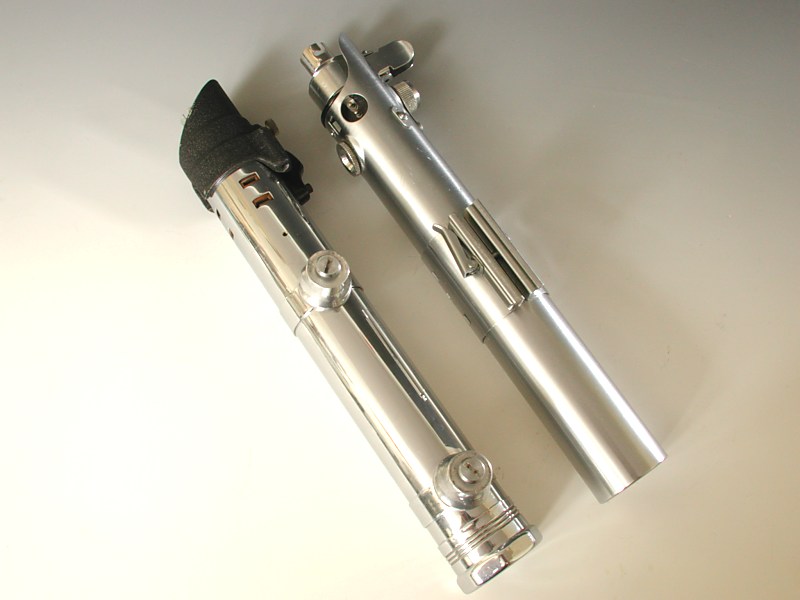
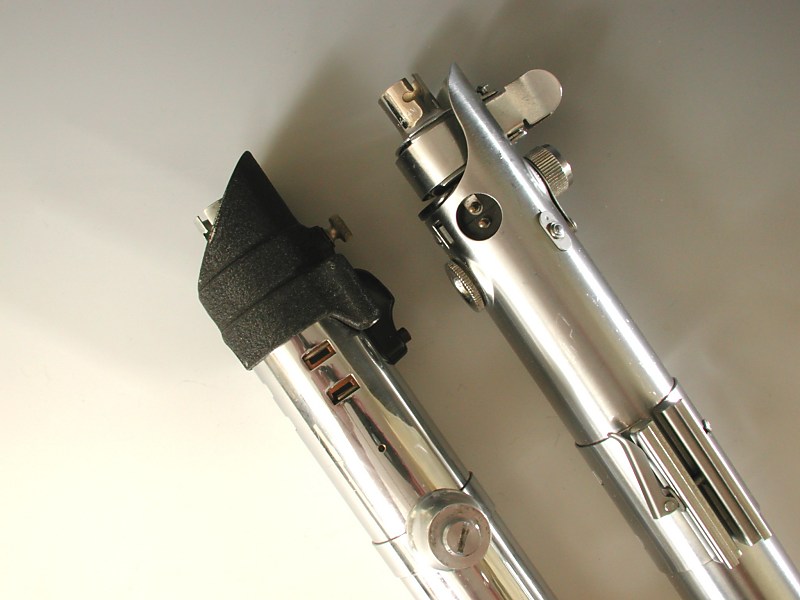
|  |
Alternate flash units. Part 1
A very good alternative is the Heiland 3 Cell Synchronar flash with black reflector shroud.
It is very well constructed synchronizer with 4 outlets and a maroon colored button. This button is used together with a Solenoid.
Weight is less than the Graflex 3 cell - 825 gram. (Graflex 3 cell has a weight of 915 gram) If weight is your prime concern and added to the weight of your camera, it is quite a bit!
You might consider the Graflex "Graflite" (modern design), which brings only 548 gram on the scale.
Measurements were taken with the cells in place but without reflector.
The handle comes in high polished chrome.Note: This is the second choice for Dart Vader fans.

Side by side comparison of the Heiland 3 cell and the Graflex 3 cell.
Either one will work on your Graflex or Linhof. Advantage of the Heiland is that all outlets will take the easy available Household plug instead of the round Bi-post socket.
Many cables from this era are brittle and can not be used safely.
|
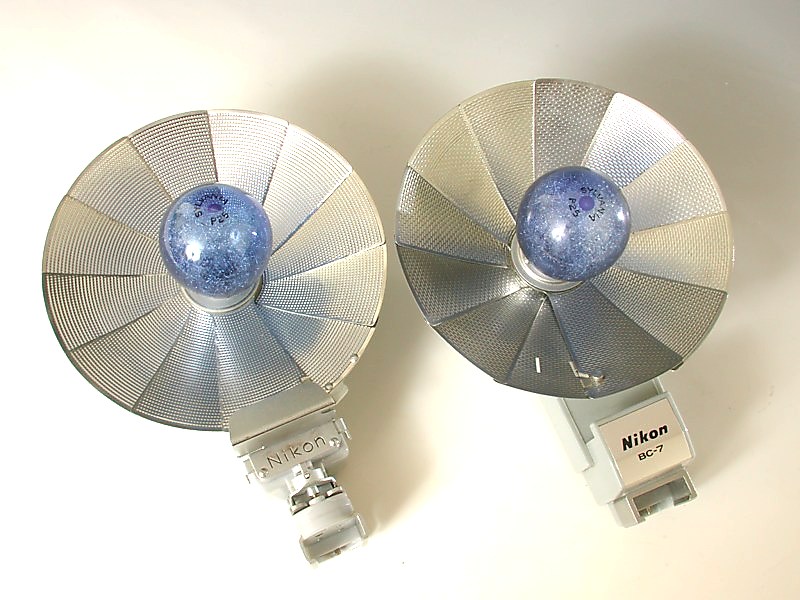
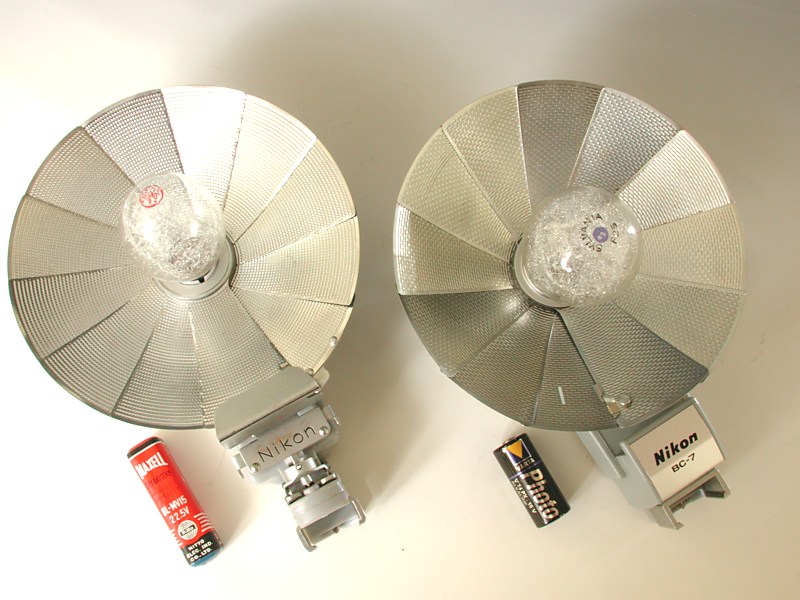
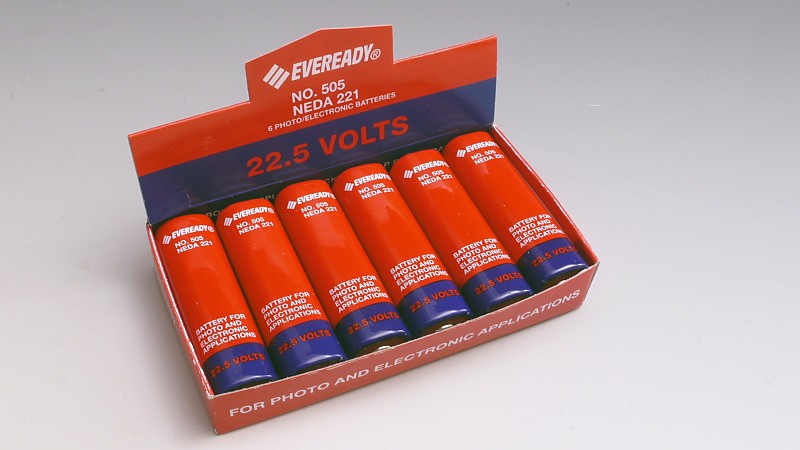
|  |
Alternate Fan-flash units. Part 2
If you want to use flash-bulbs from time to time, these smaller and later units might be interesting.
There is a belief that using bulb lighting will result in a Hollywood glamour shot that could not be done with strobes.
My personal view is that Hollywood glamour shots from the 40's were done either by flash or incandescent photo lamps. The look of those images was mainly caused by the reflectors used in those days and their typical lighting set up.
Feel free to experiment though!

Shown here are two Nikon flash units. The units are very well made with circuit tester and charging tester. With these units you can choose between several types of bulbs.
The first and common units were charged by a capacitor (Capacitor Flash). To charge and store the current either a 22.5 volts or 15 volts battery is needed.
Google or search on Ebay for: Nikon, Minolta, Leitz, Ikoblitz, Heiland etc. or just " Fan-flash for bulbs". The 15 volts batteries are still available, where the 22.5 volts are getting scarce!
I was lucky to find fresh batteries through E-bay.
A remarkable found indeed.
- Chemistry: Carbon Zinc
- mah: 60
- Volts: 22.5
- Color: Black
- Weight: 0.6 oz
- Up to 10 years estimated shelf life at room temperature.
|

////////////////////// \\\\\\\\\\\\\\\\\\\
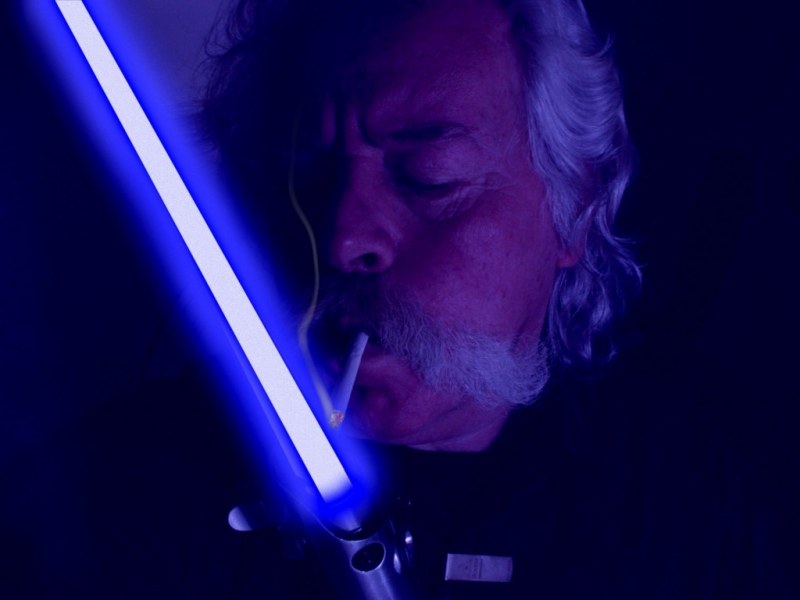
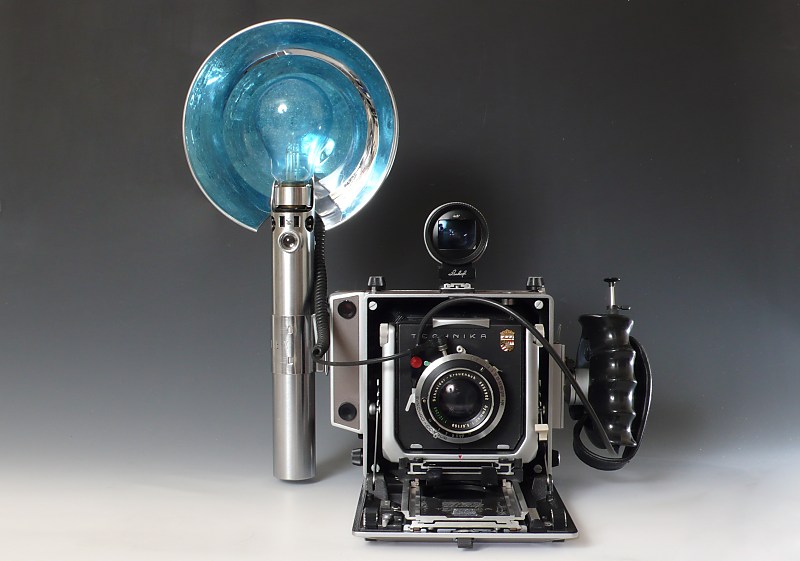
|  |
Post Scriptum :
Apart from "reheating the coffee" and "toasting a bagle" application, which indeed sounds very appealing to me, I think I will use my Graflex synchronizer occasionally on my Linhof Super Technika to incinerate some bulbs.
I must admit however, sometimes I've used the "ROJD" version when I could not find my Zippo.

My Linhof and Graflex flashgun mounted the proper way and synced by means of Bi-post (under the red button) and PC tip.(M contact)
For more information on syncing your flash with the Speed Graphic, see the other two chapters as well.
Much more information on cables, plugs and sockets can be found in there.
Finally, "May the force be with you" to withstand the idea of converting your awesome and precious Graflex synchronizer ;-)
|

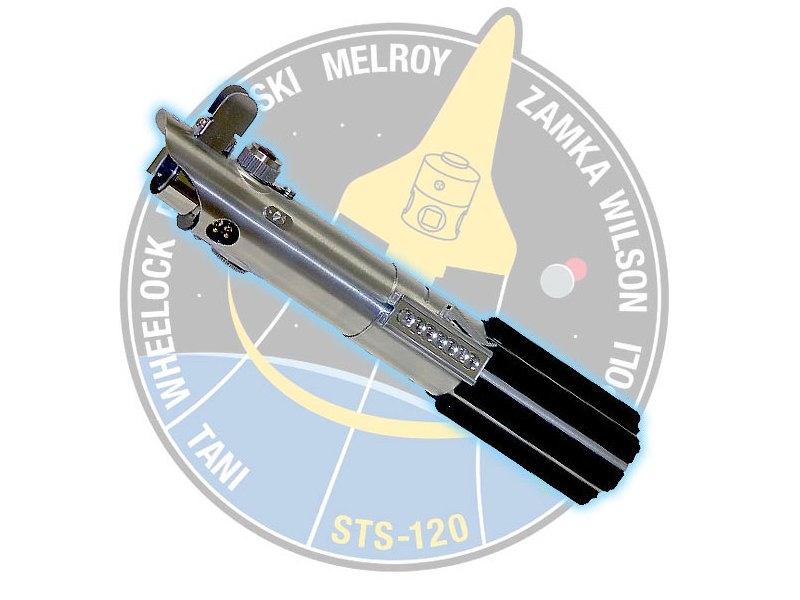
|  |
Launch confirmed:
From Newsweek
*
Space Shuttle Discovery Thunders Into Orbit, Begins Most Complex Space Station Mission Yet
10/24/2007 12:00:00 AM
CAPE CANAVERAL, Fla. — Shuttle Discovery and its crew of seven thundered into orbit Tuesday, setting off on the most challenging space station construction mission yet that will pave the way for the arrival of two science labs in a few months.
"Star Wars" director George Lucas was also on hand for the launch. Tucked amongst Discovery’s cargo is an original prop lightsaber for Luke Skywalker, which rode to space as part of the 30th anniversary of the film’s 1977 premiere.
|

 |
This page has been published and uploaded on October 23 rd 2007
On October 24 th 2007 the confirmation on "Thundering into Orbit" and the Postscriptum were added and uploaded.
All photographs were made by John D. at a Studio in Driebergen-Rijsenburg.
|

COPYRIGHT NOTICE:
PUBLISHED PHOTOGRAPHS NOR TEXT MAY USED WITHOUT WRITTEN CONSCENT OF THE AUTHOR.PHOTOGRAPHS MAY NOT BE CROPPED, RETOUCHED OR
AIRBRUSHED IN ANY WAY WITHOUT THE PERMISSION OF JOHN D. PHOTOGRAPHY.ALTERING THESE PHOTOS WITHOUT PERMISSION WILL RESULT IN CHARGES FOR DAMAGED PHOTOGRAPHS.THERE WILL BE WHATSOEVER NO CAPTURING,
RESAMPLING, SCANNING, DIGITISING OR STORAGE OF IMAGES ON A RETRIEVAL SYSTEM WITHOUT THE WRITTEN CONSENT OF THE AUTHOR. THE
NATURE OF THE CAPTIONS MUST BE RESPECTED.ALL THESE PHOTOGRAPHS ARE COPYRIGHT OF JOHN D.PHOTOGRAPHY & JOHND.ESQ © 1999,2007
|

This page is part of "The MasterSite for the larger camera"






![]()
![]()
![]()

![]()











